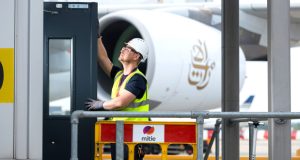 The ‘new normal’ workspace must nurture and champion the neurodiverse says David O’Coimin of www.Nookpod.com
The ‘new normal’ workspace must nurture and champion the neurodiverse says David O’Coimin of www.Nookpod.com
Business decision-makers can be forgiven for wanting to fast-forward to a time when we are free from the grip of the pandemic. With offices closed, those employees able to do so are getting work done from home and learning to adjust to a new lifestyle and rhythm. While this way of working is a no-choice necessity for now, it is also causing many to question the working practices of old and to think seriously about challenging established norms. Talk of emerging from the pandemic into a ‘new normal’ is everywhere. But what should this new normal look like?
NEURODIVERSITY
The prevalent ‘one-size-fits-all’ nature of much of today’s open-plan workspace is unsuited to many employees – or potential employees. Everybody is to some extent differently abled – ways of thinking and operating differ from one person to the next. This neurodiversity cannot be shoehorned into one type of workspace. Indeed, to do so is a recipe for problems which can result in higher-levels of absenteeism and burn-out.
If businesses are determined to make a change and to do things differently then it is absolutely essential that practical consideration is given to supporting and nurturing neurodiverse employees. Whilst great strides have been taken in recent years to understand neurodiverse behaviours, many facets of everyday life still fall behind. The workplace is one such example. Some progress has been made in terms of adapting space for physical disabilities, but it is less apparent where neurodiversity is concerned. And we understand why – it’s not always as easy and obvious to know what to do.
Different types of brains (e.g. introvert vs extrovert, neuro-diverse, autistic), different types of tasks (e.g. programming vs brainstorming), and different times of day (mid-morning vs immediately after lunch vs just before home time) form a three-dimensional matrix of conditions, and therefore needs, from a workspace. In practical terms, this does not mean a total re-design.
There are three top considerations when creating a workspace suited to neurodiverse individuals, and relatively simple solutions exist for each:
- NOISE LEVELS
Noise is the number one issue because it permeates and impacts concentration, anxiety-levels and general wellbeing. Creating an environment that enables individuals to escape from noise is key. This might be done with acoustic wall panels, ceiling panels and room dividers which can not only be used to make sound reverb less in a space, but also to sub-divide areas with differing functions and noise levels (e.g. finance team vs sales team / programmers vs dining area).
Interestingly, an environment that is too quiet can also be an issue for many, preventing them from speaking up, making calls or expressing themselves fully. White noise can be used to create a base comfortable noise level into which people feel more open to be themselves. - LIGHTING
Light is proven to have a powerful influence on mood, energy levels and the ability to process information.
Light can be used zonally, creating pockets of space that are comfortable to individuals. Different colours create different moods and can help provide sensory support for autism, dyslexia and visual impairment. - PERSONAL SPACE
It is important to enable employees to regulate their own personal space without making them feel like they are in the spotlight for doing so. Creating withdrawal spaces is key – discrete areas that provide separation without totally isolating users from the workspace. Placing these close to work desks enables people to hop casually into the space for respite or for a more intimate conversation.
These are changes that can benefit all workers. In fact, any business failing to adapt in a post-pandemic world may quickly find themselves struggling to retain or attract top talent. Many people are experiencing new ways of working for the first time. As the lockdown period extends, so these new working practices become second nature. Going back to the open-plan office routines of old will rapidly lose its appeal.
Life right now feels so different to before. No commuting, more time for yourself, more time for family, an appreciation of the freedoms that fresh air and space provide. There is a need for greater self-discipline and a requirement to get creative in order to overcome hurdles. New technology is being embraced so that teams can stay connected. Sounds great, right? And it is. There is much to take forward. But there are flip-sides too; the sense of cabin-fever, the feeling of isolation, the distractions of the household, the reliance on your own less-than-perfect technology, to say nothing of the back-breaking kitchen chair.
PLANNING FOR THE ‘NEW NORMAL WORKSPACE’
So, what’s the summary? In short, people are proving that they can be productive outside the office and are enjoying some of the work/life balance advantages that this can bring. But – and it’s a big but – there is still a strong and basic need for human interaction and socialisation. To satisfy employees and to attract the best prospects businesses will need to think hard about how they occupy space.
In considering the needs of the neurodiverse, businesses demonstrate responsibility towards individuals. And by thinking about individuals, companies start to perform better as a whole. Many of the workspace changes suggested for neurodiverse individuals focus on wellbeing, on delivering havens of calm and the opportunity to take a break from the hubbub without isolating completely from colleagues. These priorities are now also high on the wish-list of every employee – priorities formulated as they experience new ways of working.
If there is to be a ‘new normal’ in a post-COVID-19 world, now is the time to ensure that neurodiversity is a central part of that planning.




